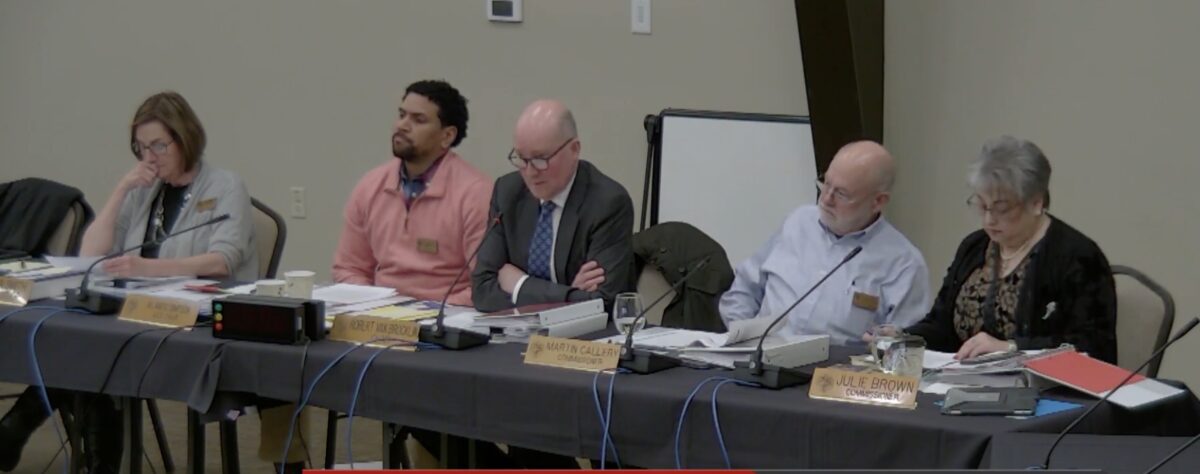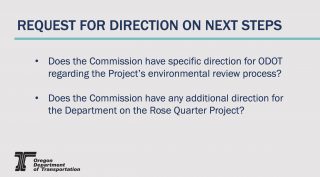
There was a big surprise at the Oregon Transportation Commission (OTC) meeting on Monday: Governor Kate Brown finally weighed on the controversial I-5 Rose Quarter project via a letter that calls for a pause on a key decision and more analysis of congestion pricing.
“I request the commission table the decision on the environmental review path for a few months.”
— Governor Kate Brown
The OTC’s five members were set to make a decision on the $500 million project at day two of their meeting on Tuesday. As we’ve been reporting, the key issue right now is whether or not the Oregon Department of Transportation should move forward with their completed environmental assessment (EA) or whether they should complete a more robust environmental impact statement (EIS).
According to ODOT, their EA proved that their plans to add lanes and widen I-5 through Portland’s central city would improve air quality and reduce greenhouse gas emissions due to “improved traffic flow” and less idling. Those are just a few of the findings project critics think would change with the additional scrutiny of EIS.
The Governor-appointed OTC oversees ODOT and the decision about how to move forward was put squarely on their shoulders when ODOT staff didn’t make a recommendation on their own.
Eager to move forward into design and engineering of the project, ODOT has resisted calls to do an EIS even as pressure has been building since last winter to do more analysis. In April, Metro’s senior planner called ODOT’s EA, “inadequate and potentially misleading”. As the list of electeds and organizations calling for the EIS piled up, Portland Mayor Ted Wheeler, Metro Council President Lynn Peterson, and Multnomah County Commissioner joined the chorus in a letter released last Friday.
Advertisement
It appears that letter finally broke the dam for the Governor. Here’s the text of Governor Brown’s letter (first reported by The Oregonian, emphases mine):
Members of the Oregon Transportation Commission,
I signed HB 2017 into law with the intention that the Rose Quarter project would bring a vital infrastructure improvement to a transportation corridor that is of statewide significance. The current configuration of the interstates intersecting at the Rose Quarter is a safety hazard to Oregonians and those visiting our state.
Having key local partners who are focused on a successful project will be critical to its long-term success, as well as the success of other major regional transportation initiatives, including the I-5 bridge replacement and congestion pricing. Based on recent feedback from our local partners, specifically the local elected officials at Metro, the city of Portland and Multnomah County, I request the commission table the decision on the environmental review path for a few months and focus on completing work on developing a leadership policy, project decision-making structure and moving forward with a third-party independent study of development alternatives for the planned highway covers. These items were requested for completion over six months ago, and ODOT has not yet completed them. In order to move forward in partnership with the region, they must be completed before and environmental review path is chosen.
Advertisement
In addition, as you move toward a decision on an environmental review path I would like you to include a full review of congestion pricing and how its implementation would impact the Rose Quarter. The pricing plan should provide an incentive to utilize other transportation modes and enhance mobility options for low-income communities and communities of color, and it should also provide greater certainty for freight haulers. We cannot build our way out of congestion by inducing greater demand on the system. We must manage demand to reduce congestion while also reducing emissions consistent with our state’s greenhouse gas emissions goals. The planned improvements along with demand management is the strategy we should pursue, and this approach has been proven to be effective in many jurisdictions around the world.
Finally, the Rose Quarter project also needs to proceed in a matter that recognizes the past injustices to impacted communities. This must include aggressive usage of minority contracting for the construction of the project. If the Portland City Council moves forward on a new district plan for lower Albina, ODOT and the Rose Quarter project will need to be significant partners. Visions being generated are compelling and have the potential to address historical injustices. I support these efforts, and ODOT needs to be a partner in them.

This letter will burnish the Governor’s claims of being a climate leader as her silence on this project — and its potential to increase driving capacity — had become a political liability.
Governor Brown’s call for more study of congestion pricing will be music to the ears of many project critics (Portland Commissioner Chloe Eudaly took a similar stance way back in April). ODOT is currently studying congestion pricing, but the agency doesn’t appear to have any urgency to do it. In a video released last March they said tolls are, “Years away at best.”
After reading the Governor’s letter today, OTC Commissioner Martin Callery expressed concern about the potential delay. “I just don’t want to see this project linger for a year, or less,” he said. Callery said he (and others commissioners) think the project is part of a “big package” with the Interstate Bridge replacement project. “I’m sure I can live with a few months delay,” he said, “But I don’t want it to last much longer.”
The exact amount of delay the Governor’s letter will cause is a big unknown. It’s notable she didn’t call for an EIS, which might signal her intention to strike a compromise between those with concerns about the project and those who want to see it break ground.
This project was one of the marquee “congestion reduction” projects in the HB 2017 transportation funding package passed by the Oregon Legislature in 2017. It’s slated to receive $30 million per year (from gas tax revenue) starting in 2022. ODOT hopes to begin design on the project in 2020 and start construction in 2023.
A presentation on the project they’ll receive from ODOT staff tomorrow asks: “Does the Commission have specific direction for ODOT regarding the Project’s environmental review process?” and, “Does the Commission have any additional direction for the Department on the Rose Quarter Project?”
Governor Brown has somewhat pre-empted their answers and it’s unclear what will happen at tomorrow’s meeting. One thing we do know is that people will show up to testify against it.
No More Freeways Coalition and Sunrise Movement responded to the Governor’s letter on Monday night. “Her encouragement of further study and implementation of congestion pricing is commendable,” they wrote, “No More Freeways and Sunrise PDX look forward to testifying at the OTC hearing in Lebanon tomorrow to ask Commissioners to their faces what leadership action they intend to take to address ODOT’s institutional complicity in exacerbating the urgent climate emergency currently unfolding.”
— Jonathan Maus: (503) 706-8804, @jonathan_maus on Twitter and jonathan@bikeportland.org
— Get our headlines delivered to your inbox.
— Support this independent community media outlet with a one-time contribution or monthly subscription.


